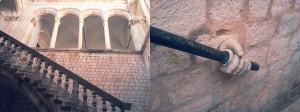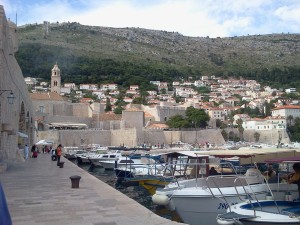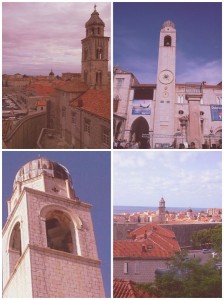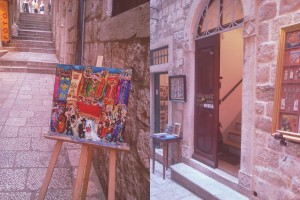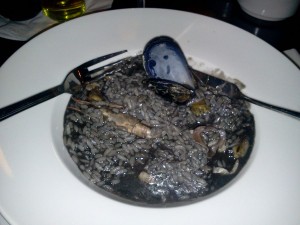Visiting Dubrovnik for the first time got me asking why I never thought about going there before. I am not surprised why it attracts so many people – there is everything for every taste… except, perhaps, budget travel. The popular Croatian city rests on the remainders of the once-prominent Republic of Ragusa, which was known for its vibrant economic and cultural life, as well as diplomacy and tolerance, in the 15th and 16th centuries. Walking in the city feels as if everything is perfectly preserved since then – but in fact its protection by UNESCO since 1979 did not prevent it from being severely bombed in 1991. Scarce remaining residents of the ancient walled city had to look for ways in which to restore their property, with strict UNESCO requirements for specific tiles and colors. Maps detailing the damage of the bombing hang next to regular tourist maps in the main sightseeing spots.
A typical street in old town Dubrovnik looks like this (click on the images to enlarge them):
When I booked my room, I had no idea I’ll have to climb over 100 steps every day. Residents know how to optimize the challenging routes, but the landlady spoke only Croatian and couldn’t explain it to me. First I was very stressed, but I later learned for friends that this situation is typical in Dubrovnik. The lady did not speak any foreign language, but she managed to run this accommodation facility nonetheless, and she made it feel like a home-stay. I had a cute clean room with many shelves and even laundry ropes. When I returned tired and hungry, the lady offered me soup and strawberries.
I got the habit of waking up early photographing objects in the morning, before hordes of tourists pour into the streets. Mornings were my favorite. I watched workers enjoying a moment of quiet, smoking and chatting before the real work starts, and they will be demanded to be efficient, ever-pleasant and multilingual. I watched people bringing their children to play in a centrally located playground with a huge magnolia tree. I could see the details of every object. I once walked into Dubrovnik’s Orthodox church and was awarded with a few mysterious and uplifting moments, listening to the only three participants of the church service, filling the incense-filled space with their chants.
Serenity is not to be looked for on the main street (the Stradun). It’s full of businesses catering for tourists. When I took a guided tour, our guide, Pave, speaking with a flawless American English accent, explained that when she was a child, there were 5,000 residents in the walled city, but only 1,000 remained. Noise, prices (there are hardly any normal shops around) and strict UNESCO regulations for property can explain that. The street starts with the Pile gate (entrance to the city walls) and a large fountain (built in 1438), and ends with the Bell Tower, where a mechanism with two sculptures creatively shows the time (a golden ball shows the phase of the moon). The mechanism had to be wound in the past, now it uses electricity. At the end of the street there is the Rector’s Palace, which used to be the seat of all the branches of the government of the Republic of Ragusa:
One of the main sights is the Old Port. Due to Dubrovnik’s importance in trade, the port and various maritime facilities (the shipyard and the quarantine (Lazareti) for potentially ill sailors) are now celebrated and visited as some of the most important symbols of Dubrovnik’s heritage. The area is now very commercial, with competing vendors selling ice-cream, souvenirs, offering tourist boats to the nearby islands, etc. There is a famous fish and seafood restaurant there, and perhaps the only sandy beach is close by.
There are places which are comfortable to sit just watching the waves and eating sweet cherries – one of the few non-commercial pleasures in Dubrovnik.
Inside the Old Town, various towers help people to orient themselves.
Wandering in the streets, I noticed an outdoor exhibition (next to the post office). An artist’s house was burned down in 1991. The painter has since created works that speak of the memory of the bombing in December 1991. He posed with his burnt frescoes and paintings, and the mini-memorial lists all the artworks and other valuables that were destroyed by the fire. He lost a huge personal library and a number of sketches as well. The memorial makes the historical fact of bombing personal and intimate, and the connection between the artworks destroyed and artworks created through recycling and inspiration from the bombing experience.
In another old town street, which is named the Jewish street, I notice a compulsory Eastern European ‘Jewish Disneyland’ – a series of Judaica gift shops and tourist facilities. These things lead to Dubrovnik’s synagogue, which was built in the 16th century by the city’s Sephardic community. The founders of the community first came to trade corals, before inquisition. There are still donation boxes with cities in nowadays Israel/Occupied Territories, where members of Dubrovnik’s community donated to the communities in the Holy Land. The museum adjacent to the synagogue shows a document dating 1421, a residency registration of a Catalan Jew in Dubrovnik. Various documents are written in Croatian and Italian, and the official stamp reads “Comunita Israelitica”. Although Dubrovnik boasts of its tolerance in the middle ages, a 16th century order requests the Jewish population to wear badges to distinguish themselves from Christians and to live in a specific quarter. All discrimination against the Jewish people was abolished during the French conquest. The lady who sells tickets explained that the synagogue was still functioning, but not every Saturday, since the community is tiny and old, young people have largely assimilated. A rabbi has to come all the way from Zagreb to hold religious services. “I don’t know how religious rituals are performed here, because I’m not Jewish and I’m not allowed to participate,” says the worker of the Jewish museum and synagogue. Outside, I hear an Israeli tour guide tell her clients in Hebrew that they can visit the synagogue in the evening if they wish.
Walking away from there, I get an invitation to try Dead Sea products. It turns out that the shop assistant is Israeli. We chat in Hebrew about life in Dubrovnik – she is the first local (sort of) that I can talk to.
Here’s a quick list of things I did and could recommend in Dubrovnik:
- Sea food restaurants: a definite must. The one at the port is the most famous, but there are some in the center too. Croatian black risotto was the most exotic food I’ve eaten this year.
- Staying at the “Old Town Inn”: one must be aware of the limitations. It is a very cute mini-hotel, which makes you feel at home (the bathroom facilities are shared with another room, there is a washing machine and even laundry drying ropes outside the window (things that tourists take photos of), high-speed internet and a fridge. But 100+ steps make this accommodation unsuitable to people with health problems. Also, the administrator does not speak any foreign language.
- Trip to the Lokrum island and city walls – definitely worth the money (will blog about it later).
- Nightlife: let’s say that Dubrovnik was not made for that.



